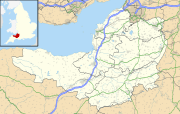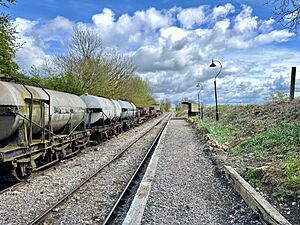East Somerset Railway facts for kids
Quick facts for kids East Somerset Railway |
|
|---|---|
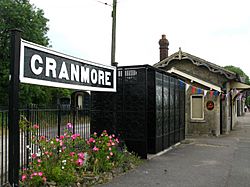
Cranmore railway station is the line's headquarters
|
|
| Locale | Somerset |
| Commercial operations | |
| Original gauge | 7 ft 1⁄4 in (2,140 mm) Brunel gauge |
| Preserved operations | |
| Length | 1 mi 63 ch (2.9 km) |
| Preserved gauge | 4 ft 8 1⁄2 in (1,435 mm) standard gauge |
| Commercial history | |
| Opened | 9 November 1858 |
| 1 March 1862 | Extension opened |
| 1874 | Converted to 4 ft 8 1⁄2 in (1,435 mm) standard gauge |
| Closed to passengers | 1963 |
| Closed | 1985 |
| Preservation history | |
| 1972 | Restoration (of the ESR) begins |
| 1974 | ESR Granted Light Railway Order |
| 1975 | ESR re-opened |
| 1981 | ESR extended to Merryfield halt |
| 1985 | ESR extended into Mendip Vale |
| Headquarters | Cranmore |
The East Somerset Railway is a special train line in Somerset, England. It's about 1 mi 63 ch (2.9 km) long. This railway is called a heritage railway because it keeps old trains and tracks working for people to enjoy. It runs between two stations: Cranmore and Mendip Vale.
Long ago, this railway was part of a bigger line called the Cheddar Valley line. This line went from Witham to Yatton. It even connected with another railway at Wells. Even before a big plan in 1963 to close many British railways, the East Somerset Railway was already thought about for closure.
Contents
History of the Railway
| East Somerset Railway Act 1856 | |
|---|---|
| Act of Parliament | |

|
|
| Long title | An Act for making a Railway from the Wilts, Somerset, and Weymouth Railway, near Frome, to Shepton Mallett in the County of Somerset. |
| Citation | 19 & 20 Vict. c. xvi |
| Dates | |
| Royal assent | 5 June 1856 |
| Text of statute as originally enacted | |
| East Somerset Railway (Extension to Wells) Act 1857 | |
|---|---|
| Act of Parliament | |

|
|
| Long title | An Act to authorize the East Somerset Railway Company to extend their Railway from Shepton Mallett to Wells. |
| Citation | 20 & 21 Vict. c. cv |
| Dates | |
| Royal assent | 27 July 1857 |
| Text of statute as originally enacted | |
| East Somerset Railway Act 1860 | |
|---|---|
| Act of Parliament | |

|
|
| Citation | 23 & 24 Vict. c. lxxiii |
| Dates | |
| Royal assent | 14 June 1860 |
| Text of statute as originally enacted | |
The East Somerset Railway Company was officially started on June 5, 1856. It was built with a special wide track called a 7 ft 1⁄4 in (2,140 mm) broad gauge line. The first part of the line opened on November 9, 1858. It ran between Witham station and Shepton Mallet. Famous engineer Mr. Brunel helped plan it.
The station buildings and bridges were made from local stone. This meant Shepton Mallet was now about 129 miles (208 km) from London by train. The journey took just over four hours.
Four years later, on March 1, 1862, the line was made longer to reach Wells. This made the railway 13 mi 65 ch (22.2 km) long. The Great Western Railway bought the East Somerset Railway on December 2, 1874. Soon after, the tracks were changed to the standard 4 ft 8 1⁄2 in (1,435 mm) standard gauge width.
In 1878, the Great Western Railway connected the East Somerset line with the Cheddar Valley line. This allowed trains to run all the way from Yatton to Witham. The original East Somerset Railway station in Wells closed. Instead, Wells (Tucker Street) became the main station for the city. Passenger trains stopped running on September 7, 1963. However, trains carrying bitumen (a tar-like material) continued until 1985.
Bringing the Railway Back to Life
In 1971 and 1972, a famous artist named David Shepherd bought Cranmore station. He also bought a section of the track. He wanted a place to keep and run his two steam locomotives. These were the powerful British Rail (BR) 2-10-0 Class 9F No. 92203 "Black Prince" and the BR Standard 4 4-6-0 No. 75029 'The Green Knight'.
In 1973, the railway started offering rides in brake vans. These are special wagons used for braking. Over the years, the line was extended. It reached Merryfield Lane in 1980, then Mendip Vale, and finally back into Cranmore station in 1985.
Today, the East Somerset Railway (ESR) runs trains between Cranmore, Cranmore West, Merryfield Lane Halt, and Mendip Vale. Part of the railway goes through the Doulting Railway Cutting. This area is special for its nature. Another section of the track is used by heavy quarry trains. These trains carry materials from the nearby Merehead Quarry.
In 1991, a new station building was built at Cranmore. It now has a cafe, a place to buy tickets, a gift shop, and toilets. The platform leads to the old station, which is now a museum. On the platform, you can see a rare old red telephone box from around 1927. It's one of only 50 ever made! Across from the platform is a signal box from 1904. It looks just like the ones the Great Western Railway used back then. Near Cranmore station are the engine sheds and workshop, built in 1973. This is where the trains are kept and repaired.
A company called Cranmore Traincare and Maintenance and Services (CTMS) started in 1995. They are based at Cranmore and professionally repair train carriages. They also work on the bodies of diesel locomotives.
In 2005, the government allowed the railway to use another 660 yards (600 meters) of track. In 2007, the East Somerset Railway received a grant of £7,500. This money was for studying how to extend the line towards Shepton Mallet. They hoped to build a new station at Cannards Grave.
Locomotives at East Somerset Railway
Steam Locomotives Running Today
These are some of the steam trains you might see running at the East Somerset Railway.
| Number & name | Type | Wheels | Built | To ESR | Notes | Image |
|---|---|---|---|---|---|---|
| 46447 | LMS Ivatt Class 2 | 2-6-0 | 1950 | 2012 | This locomotive was built in 1950. It was saved from a scrapyard in 1972. After some repairs elsewhere, it was finished at Cranmore. It ran its first train on October 26, 2014. | 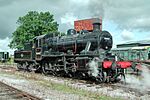 |
| 4110 | GWR 5101 | 2-6-2T | 1936 | 2020 | Built in 1936, 4110 was saved from a scrapyard in 1979. It moved to Cranmore in 2020. Once fully repaired, it will run at the East Somerset Railway for three years. |  |
| Lady Nan | Andrew Barclay Sons & Co. | 0-4-0ST | 1920 | 1975 | This train was built in 1920. It worked for many years under different names. It was saved from scrap in 1972 and came to the railway in 1975. It was named Lady Nan in 1985 and is painted blue. |  |
Other steam locomotives that have visited or lived here include 5637, 92203 "Black Prince", 75029 The Green Knight, 76017, 5029 Nunney Castle, 34027 'Taw Valley', 34105 Swanage, 828, 7822 Foxcote Manor, 1450, 110, 47493, 69023 'Joem', and 68846.
Steam Locomotives Being Repaired
These steam trains are currently being worked on to get them running again.
| Number & name | Class | Wheel arrangement | Built | To ESR | Notes | Image |
|---|---|---|---|---|---|---|
| 31 Meteor | RSH | 0-6-0T | 1950 | ? | This locomotive is currently undergoing repairs. | |
| 4247 | GWR 5205 | 2-8-0T | 1916 | 2021 | This train is also being repaired to return to service. | 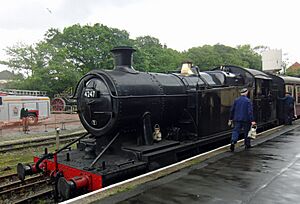 |
Diesel Trains
The East Somerset Railway also has diesel trains, including a passenger unit and several shunting locomotives.
| Number & name | Type | Built | To ESR | Notes | Image |
|---|---|---|---|---|---|
| L231 (51909 & 56271) | Class 108 | 1960 | 2013 | This is a two-car diesel passenger train. It was retired in 1993 and came to Cranmore in 2013. It has been restored and is painted in British Rail blue. |  |
| DH16 | 0-4-0DH CD Sentinel |
1964 | 2015 | Built in 1964, this shunter worked at the Manchester Ship Canal. It came to the East Somerset Railway in 2015. |  |
| 39 | 0-6-0DH SR Sentinel |
1965 | 1999 | This shunter was built in 1965 and worked for the Port of Bristol Authority. It arrived at Cranmore in 1999 and is privately owned. | 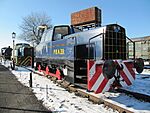 |
| 42 Eric | 0-6-0DH SR Sentinel |
1965 | 2007 | Built in 1965, this shunter also worked for the Port of Bristol Authority. It was later named Eric and donated for preservation. |  |
| 199 | 0-4-0DH CD Sentinel |
1964 | 2007 | This shunter was built in 1964 for Esso Petroleum. It was given to the preservation group in 2007. | 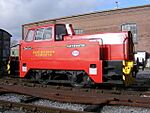 |
| Joan | 0-4-0DH SR Sentinel |
1963 | 2005 | Built in 1963, this locomotive was a demonstration model. It arrived at Cranmore in 2005 and was restored in 2017. | 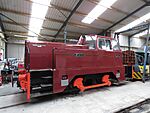 |
Railway Features
The East Somerset Railway line from Cranmore to Mendip Vale is about 1 mile 63 chains (2.9 km) long.
| Point | Coordinates (links to map & photo sources) |
Notes |
|---|---|---|
| Cranmore railway station | 51°11′06″N 2°28′41″W / 51.185°N 2.478°W | Eastern start of railway line |
| Cranmore West railway station | 51°11′02″N 2°28′59″W / 51.184°N 2.483°W | |
| Merryfield Lane railway station | 51°10′52″N 2°29′53″W / 51.181°N 2.498°W | |
| Mendip Vale railway station | 51°10′48″N 2°31′12″W / 51.180°N 2.520°W | Western terminus |


